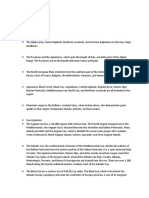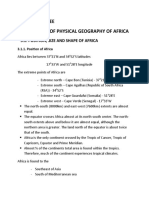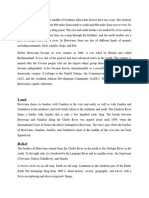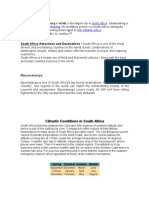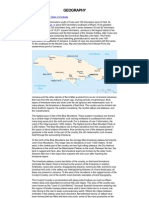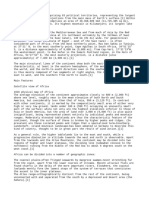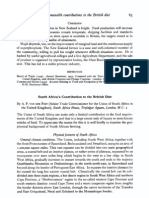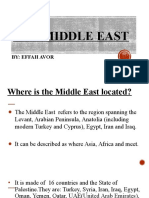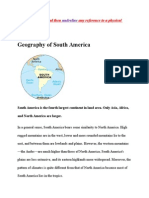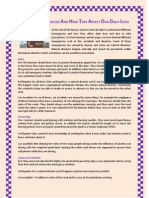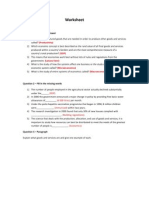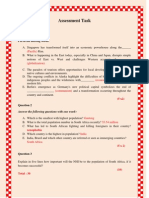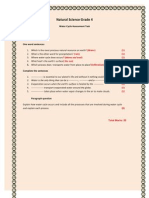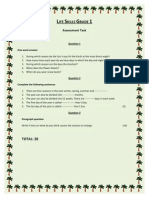South Africa Geo
South Africa Geo
Uploaded by
joe_boyCopyright:
Available Formats
South Africa Geo
South Africa Geo
Uploaded by
joe_boyCopyright
Available Formats
Share this document
Did you find this document useful?
Is this content inappropriate?
Copyright:
Available Formats
South Africa Geo
South Africa Geo
Uploaded by
joe_boyCopyright:
Available Formats
South Africa's geography
South Africa occupies the southern tip of Africa, its long coastline stretching more than 2 500km from the desert border with Namibia on the Atlantic coast, southwards around the tip of Africa, then north to the border with subtropical Mozambique on the Indian Ocean. The low-lying coastal zone is narrow for much of that distance, soon giving way to a mountainous escarpment that separates it from the high inland plateau. In some places, notably the province of KwaZulu-Natal in the east, a greater distance separates the coast from the escarpment. Size and provinces South Africa is a medium-sized country, with a total land area of slightly more than 1.2-million square kilometres, making it roughly the same size as Niger, Angola, Mali and Colombia. It is one-eighth the size of the US, twice the size of France and over three times the size of Germany. South Africa measures some 1 600km from north to south, and roughly the same from east to west. Map: Mary Alexander, MediaClubSouthAfrica.com The country has nine provinces, which vary considerably in size. The smallest is tiny and crowded Gauteng, a highly urbanised region, and the largest the vast, arid and empty Northern Cape, which takes up almost a third of South Africa's total land area. To find out more about South Africa's provinces, follow the links in the box on the right. Borders On dry land, going from west to east, South Africa shares long borders with Namibia and Botswana, touches Zimbabwe, has a longitudinal strip of border with Mozambique to the east, and lastly curves in around Swaziland before re-joining Mozambique's southern border. In the interior, nestled in the curve of the bean-shaped Free State is the small mountainous country of Lesotho, completely surrounded by South African territory. Cities South Africa has three capitals: Cape Town, Bloemfontein and Pretoria. The Western Cape city of Cape Town, where the country's Parliament is found, is the legislative capital. In the Free State, Bloemfontein is the judicial capital, and home to the Supreme Court of Appeal. In Gauteng province, Pretoria, where the Union Buildings and a large proportion of the civil service are found, is the administrative capital, and the ultimate capital of the country. The largest and most important city is Johannesburg, the economic heartland of the country. Other important centres include Durban and Pietermaritzburg in KwaZulu-Natal, and Port Elizabeth in the Eastern Cape.
Climate and topography Although the country is classified as semi-arid, it has considerable variation in climate as well as topography.
The great inland Karoo plateau, where rocky hills and mountains rise from sparsely populated scrubland, is very dry, and gets more so as it shades in the north-west towards the Kalahari desert. Extremely hot in summer, it can be icy in winter. Habitat types: South Africa has seven major terrestrial biomes, or habitat types - broad ecological life zones with distinct environmental conditions and related sets of plant and animal life. In contrast, the eastern coastline is lush and well watered, a stranger to frost. The southern coast, part of which is known as the Garden Route, is rather less tropical but also green, as is the Cape of Good Hope - the latter especially in winter. This south-western corner of the country has a Mediterranean climate, with wet winters and hot, dry summers. Its most famous climatic characteristic is its wind, which blows intermittently virtually all year round, either from the south-east or the north-west. The eastern section of the Karoo does not extend as far north as the western part, giving way to the flat landscape of the Free State, which though still semi-arid receives somewhat more rain. North of the Vaal River, the Highveld is better watered, and saved by its altitude (Johannesburg lies at 1 740m; its average annual rainfall is 760mm) from subtropical extremes of heat. Winters are cold, though snow is rare. Further north and to the east, especially where a drop in altitude beyond the escarpment gives the Lowveld its name, temperatures rise: the Tropic of Capricorn slices through the extreme north. This is also where one finds the typical South African Bushveld of wildlife fame. Those looking for an opportunity to ski in winter head for the high Drakensberg mountains that form South Africa's eastern escarpment, but the coldest place in the country is Sutherland in the western Roggeveld Mountains, with midwinter temperatures as low as -15C. The deep interior provides the hottest temperatures: in 1948 the mercury hit 51.7C in the Northern Cape Kalahari near Upington.
See: South Africa's weather and climate
Oceans and rivers
By far South Africa's biggest neighbour is the ocean - or two oceans, which meet at the southwestern corner. Its territory includes Marion and Prince Edward Islands, nearly 2 000km from Cape Town in the Atlantic Ocean.
The cold Benguela current sweeps up from the Antarctic along the Atlantic coast, laden with plankton and providing rich fishing grounds. The east coast has the north-to-south Mozambique/Agulhas current to thank for its warm waters. These two currents have a major effect on the country's climate, the ready evaporation of the eastern seas providing generous rainfall while the Benguela current retains its moisture to cause desert conditions in the west.
Several small rivers run into the sea along the coastline, but none are navigable and none provide useful natural harbours. The coastline itself, being fairly smooth, provides only one good natural harbour, at Saldanha Bay north of Cape Town. A lack of fresh water prevented major development here.
Nevertheless, busy harbours exist at Richards Bay and Durban in KwaZulu-Natal, East London and Port Elizabeth in the Eastern Cape, and Mossel Bay and Cape Town in the Western Cape. An additional commercial port, the Port of Ngqura, is being developed off the coast from Port Elizabeth.
There are only two major rivers in South Africa: the Limpopo, a stretch of which is shared with Zimbabwe, and the Orange (with its tributary, the Vaal) which runs with a variable flow across the central landscape from east to west, emptying into the Atlantic Ocean at the Namibian border.
In so dry a country, dams and irrigation are extremely important: the largest dam is the Gariep on the Orange River.
Read more: http://www.southafrica.info/about/geography/geography.htm#ixzz1alPVUwUU
You might also like
- South Africa's Weather and Climate - South Africa GatewayDocument1 pageSouth Africa's Weather and Climate - South Africa Gatewayashley.hansen7No ratings yet
- South Africa By-Saksham Gupta & Harshit Pratap SinghDocument33 pagesSouth Africa By-Saksham Gupta & Harshit Pratap SinghSaksham Gupta100% (1)
- South AfricaDocument2 pagesSouth AfricaTeresaNo ratings yet
- WGEODocument5 pagesWGEOJaymore BautistaNo ratings yet
- 4land and PeopleDocument12 pages4land and PeopleRethabileNo ratings yet
- Geography of AfricaDocument3 pagesGeography of Africajohnnyvado336No ratings yet
- Climate and WeatherDocument4 pagesClimate and WeatherAlberto MacamoNo ratings yet
- 19 Script200304080803034646Document6 pages19 Script200304080803034646chahey825No ratings yet
- Yb 2023Document265 pagesYb 2023Maruwa RabeleNo ratings yet
- Geography Grade 11 Unit 3Document35 pagesGeography Grade 11 Unit 3Mesobewerk EliasNo ratings yet
- Acting 266 ProposalDocument3 pagesActing 266 ProposalFernando TalubanNo ratings yet
- Physical Features For Students - West AfricaDocument7 pagesPhysical Features For Students - West AfricaJoseph Zotoo100% (4)
- Grade 5 GeographyDocument18 pagesGrade 5 Geographyjessica.dayaNo ratings yet
- Algeria 1Document17 pagesAlgeria 1Sayantan ChoudhuryNo ratings yet
- Ashura Encyclopedia Dictionary A Reference Guide to People Places Events Concepts Rituals 1st Edition Muhammad Reza Fakhr Rohani all chapter instant downloadDocument40 pagesAshura Encyclopedia Dictionary A Reference Guide to People Places Events Concepts Rituals 1st Edition Muhammad Reza Fakhr Rohani all chapter instant downloadimialirik100% (24)
- Continents and Regions - A Variety of LandscapesDocument16 pagesContinents and Regions - A Variety of LandscapesJorge A VillarrealNo ratings yet
- Nat Area BookletDocument48 pagesNat Area BookletJose TarifeNo ratings yet
- Namibia (: ListenDocument4 pagesNamibia (: ListenrNo ratings yet
- International Business: Assignment - 1 NewzealandDocument15 pagesInternational Business: Assignment - 1 NewzealandSaurabh SinghNo ratings yet
- Physical Geography of AfricaDocument23 pagesPhysical Geography of AfricaFalilou100% (1)
- Our WorldDocument29 pagesOur Worldapi-288228945No ratings yet
- AfricaDocument2 pagesAfrica-Samra-No ratings yet
- Major Climatic Regions of The WorldDocument3 pagesMajor Climatic Regions of The Worldsotonye george100% (1)
- Geography Questions AfricaDocument1 pageGeography Questions AfricaEnlai Rooney100% (1)
- KOPPENDocument6 pagesKOPPENParas AryaNo ratings yet
- Climatic Conditions of AfricaDocument2 pagesClimatic Conditions of AfricaNiraj ChaudhariNo ratings yet
- Chapter 19 Lesson 1Document7 pagesChapter 19 Lesson 1Emma SafwatNo ratings yet
- AfricaDocument18 pagesAfricaSusie SabinaNo ratings yet
- BOTSWANADocument3 pagesBOTSWANAbyrumNo ratings yet
- The Rough Guide to South Africa, Lesotho & Eswatini: Travel Guide eBookFrom EverandThe Rough Guide to South Africa, Lesotho & Eswatini: Travel Guide eBookNo ratings yet
- Landforms Climate and Vegetation of AfricaDocument20 pagesLandforms Climate and Vegetation of AfricaS Afsana RahmanNo ratings yet
- Knowledge Geography Africa PDFDocument7 pagesKnowledge Geography Africa PDFOliver SansumNo ratings yet
- Regions of The WorldDocument4 pagesRegions of The WorldsujsamNo ratings yet
- Africa - InglêsDocument12 pagesAfrica - InglêsLaudino da CostaNo ratings yet
- ClimateDocument7 pagesClimaterichele parinasNo ratings yet
- JohannesburgDocument1 pageJohannesburgŁøłą Prįńçęšś ÇøšmęNo ratings yet
- GEOG 300_NOTES MCDocument88 pagesGEOG 300_NOTES MChwanjala78No ratings yet
- CH 13 (Africa) FDocument5 pagesCH 13 (Africa) FXain RanaNo ratings yet
- CariboriginDocument2 pagesCariboriging.ponmudiNo ratings yet
- Vocabulary de GeographyDocument5 pagesVocabulary de Geographyluis car bazan vegNo ratings yet
- Newnotehnd 2Document51 pagesNewnotehnd 2sotonye georgeNo ratings yet
- 1Document4 pages1smartgamer953No ratings yet
- August 29 The African ContinentDocument17 pagesAugust 29 The African ContinentaristidekilNo ratings yet
- CHP 20 Major Natural Regions of The WorldDocument61 pagesCHP 20 Major Natural Regions of The WorldAlfiya PathanNo ratings yet
- Eastern CapeDocument12 pagesEastern CapesakuraleeshaoranNo ratings yet
- Patterns of Climate: Enviropedia Climate Change Global Warming Ozone Air Pollution Weather & Climate Sustainability KidsDocument5 pagesPatterns of Climate: Enviropedia Climate Change Global Warming Ozone Air Pollution Weather & Climate Sustainability KidsVimal NairNo ratings yet
- Commonwealth Contributions To The British Diet: ConclusionDocument7 pagesCommonwealth Contributions To The British Diet: ConclusionIoana NicolaeNo ratings yet
- Some Fun Facts About A CountryDocument11 pagesSome Fun Facts About A CountryGia Khánh 11D2No ratings yet
- THE MIDDLE EAST EffahDocument22 pagesTHE MIDDLE EAST EffahEffah AvorNo ratings yet
- 1 The RhinelandsDocument4 pages1 The RhinelandsYaboi MattNo ratings yet
- Dominican Republic GeographyDocument4 pagesDominican Republic GeographyCristián MoralesNo ratings yet
- Africa& Horn of AfricaDocument69 pagesAfrica& Horn of AfricaSupriya DagaNo ratings yet
- Patterns of Climate: Enviropedia Climate Change Global Warming Ozone Air Pollution Weather & Climate Sustainability KidsDocument5 pagesPatterns of Climate: Enviropedia Climate Change Global Warming Ozone Air Pollution Weather & Climate Sustainability KidsVimal NairNo ratings yet
- HHHHDocument2 pagesHHHHniyazibrahim78No ratings yet
- About Nigeria by YusufDocument9 pagesAbout Nigeria by Yusufquwiyyiayomide1No ratings yet
- Africa ClimateDocument44 pagesAfrica ClimateA. BaptistNo ratings yet
- Geography of South AmericaDocument8 pagesGeography of South Americaapi-269405494100% (1)
- The American Southeast, A Guide To Florida and Adjacent Shores - A Golden Regional Guide (1959)Document168 pagesThe American Southeast, A Guide To Florida and Adjacent Shores - A Golden Regional Guide (1959)Kenneth100% (3)
- Europe-WPS OfficeDocument34 pagesEurope-WPS OfficeJunriv RiveraNo ratings yet
- SummaryDocument1 pageSummaryjoe_boyNo ratings yet
- Human Physiology SummaryDocument1 pageHuman Physiology Summaryjoe_boyNo ratings yet
- A Summary of AdditionDocument2 pagesA Summary of Additionjoe_boyNo ratings yet
- Work SheetDocument3 pagesWork Sheetjoe_boyNo ratings yet
- Instructions and Information Answer ALL The Questions: Electrical Technology Grade 10Document1 pageInstructions and Information Answer ALL The Questions: Electrical Technology Grade 10joe_boyNo ratings yet
- Worksheet: Answer The Following Questions With One WordDocument2 pagesWorksheet: Answer The Following Questions With One Wordjoe_boyNo ratings yet
- Worksheet: Simplify The Following ProblemsDocument1 pageWorksheet: Simplify The Following Problemsjoe_boyNo ratings yet
- Econimics WorksheetDocument1 pageEconimics Worksheetjoe_boyNo ratings yet
- Social Achievements of The RDPDocument2 pagesSocial Achievements of The RDPjoe_boyNo ratings yet
- On The Right Column Write Down The Name of The Following PicturesDocument3 pagesOn The Right Column Write Down The Name of The Following Picturesjoe_boyNo ratings yet
- Human GeographyDocument1 pageHuman Geographyjoe_boyNo ratings yet
- Assessment TaskDocument1 pageAssessment Taskjoe_boyNo ratings yet
- Verbs and AdverbsDocument2 pagesVerbs and Adverbsjoe_boyNo ratings yet
- Assessment TaskDocument1 pageAssessment Taskjoe_boyNo ratings yet
- AssessmentDocument1 pageAssessmentjoe_boyNo ratings yet
- Assessment TaskDocument1 pageAssessment Taskjoe_boyNo ratings yet
- How To Build A Small HouseDocument7 pagesHow To Build A Small Housejoe_boyNo ratings yet



